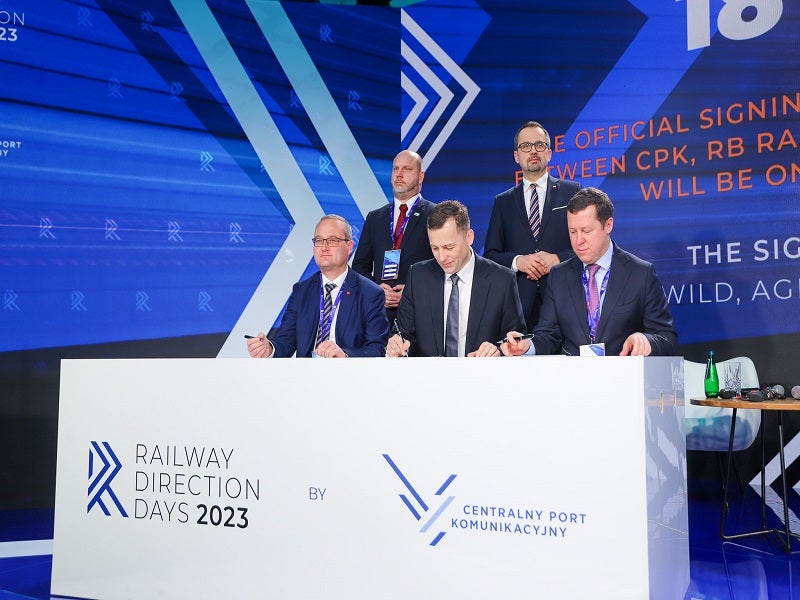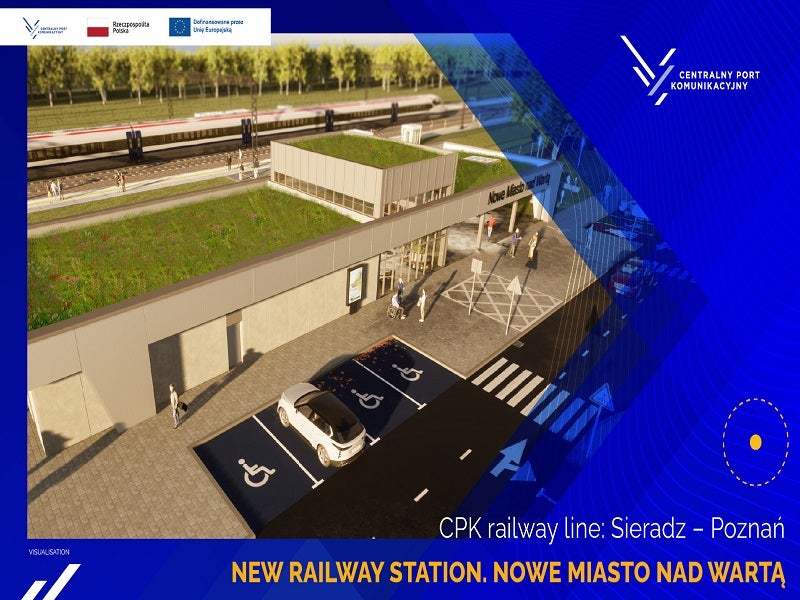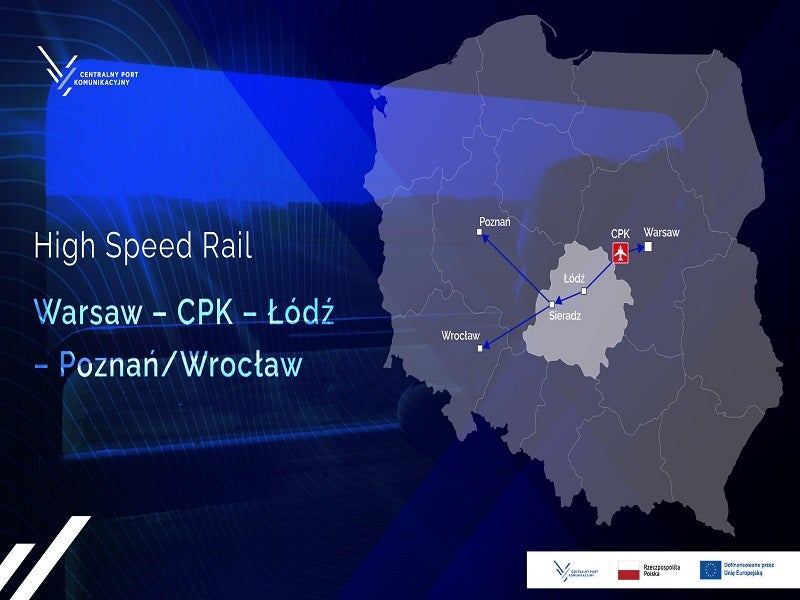The new high-speed railway (HSR) network in Poland will be developed by Centralny Port Komunikacyjny (CPK), a state-owned company.
The HSR network will be developed as part of the CPK project, a megaproject of the government of Poland to create a planned comprehensive transportation hub between Warsaw and Lodz. The CPK project plan includes the development of a new airport, a railway network and road transport.
Preparatory construction work for the HSR project is scheduled to begin at the end of 2023. The project is expected to be implemented in phases until 2040.
Upon securing the necessary permits, major construction work on the Warsaw–Łódź section will commence in 2024. The first section of the Warsaw – Łódź HSR is expected to begin operations by 2028, around the same time as the launch of the first stage of the CPK Airport.
High-speed railway project details
The HSR railway programme aims to construct 2,000km of new lines. It is expected to reduce travel time between Warsaw and other major Polish cities to under 2.5 hours.
The project will include the development of 12 railway routes, including ten spokes connecting Warsaw and CPK with different regions of the country.
The project, along with Rail Baltica and Visegrad Group countries’ (V4) HSR, will play a critical role in the EU’s Trans-European Transport Network (TEN-T).
The design speed of the Polish HSR lines is 350km/h. Trains operating on the lines will achieve an operating speed of 250km/h.
Route details
Spoke 1 comprises the CK – Płock – Włocławek – Grudziądz – Tczew – Tricity (Central Trunk Line North) – Lębork – Słupsk, and Włocławek – Toruń – Bydgoszcz – Piła – Szczecinek – Białogard – Kołobrzeg lines.
Spoke 2 includes the line connecting CPK, Warsaw, Nasielsk, Ciechanów, Działdowo, and Olsztyn.
The CPK – Warsaw – Zielonka – Tłuszcz – Czyżew – Białystok – Kuźnica, Białystok – Ełk – Suwałki – Trakiszki, and Tłuszcz – Ostrołęka – Łomża – Pisz – Orzysz – Giżycko lines constitute Spoke 3.
Spoke 4 includes the line connecting CPK, Warsaw, Siedlce, Łuków, Biała Podlaska, and Terespol.
The CPK – Warsaw – Otwock – Lublin – Trawniki – Chełm, and Trawniki – Krasnystaw – Zamość – Tomaszów Lubelski – Bełżec lines form Spoke 5.
Spoke 6 comprises the CPK – Grójec – Warka – Radom – Iłża – Ostrowiec Świętokrzyski – Stalowa Wola – Łętownia – Rzeszów – Sanok, and Rzeszów – Jasło – Krosno lines.
The CPK – CMK – Węzeł Małopolsko-Śląski (WMŚ – Lesser Poland-Silesia Hub) – Kraków – Podłęże – Nowy Sącz/Chabówka, WMŚ – Czechowicz-Dziedzice – Jastrzębie Zdrój, WMŚ – Katowice, and Central Trunk Line – Opoczno – Końskie – Kielce – Busko Zdrój – Tarnów – Nowy Sącz – Muszyna constitute Spoke 7.
Spoke 8 includes the CPK – Skierniewice – Częstochowa – Opole – Nysa – Kłodzko line.
Spoke 9 consists of the CPK – Łódź – Sieradz – Wieruszów – Wrocław – Świdnica – Wałbrzych – Lubawka, Sieradz – Kalisz – Poznań – Szczecin – Szczecin Goleniów, Kalisz – Ostrów Wlkp. – Leszno – Głogów – Zielona Góra, and Poznań – Zbąszynek – Gorzów Wielkopolski lines.
The final spoke (Spoke 10) includes the CPK – Warsaw – Sochaczew – Kutno – Konin – Swarzędz – Poznań line.
The CPK programme will also include connections to the border areas of the Czech Republic, Ukraine, Slovakia, Lithuania, Belarus and the Kaliningrad Oblast.
A Y-shaped line connecting Poland’s major cities, Warsaw, Łódź, Poznań and Wrocław, is a core line of the new HSR system.
It includes a 140km-long section between Warsaw and Łódź and a 200km-long section between Łódź and Wrocław. The Warsaw-Łódź section is part of Spoke 9.
The section between Sieradz, Kalisz, and Poznań forms the third CPK investor variant for the Y line. The length of the Poznań-Sieradz section is 155km, with most of the section located in the Wielkopolskie-Voivodeship region.
The 4km HSR tunnel in Łódź is at an advanced stage compared to other CPK investments.
The Katowice-Ostrava section is an important part of the TEN-T project. The railway line, which is part of the V4 project, will connect Krakow, Katowice, and Warsaw with Brno, Bratislava, Prague, Vienna and Budapest. The optimum route selected for the section will reduce environmental impact and enable the construction of new railway stations in Żory Północne and Mszana, an intermodal terminal in Wodzisław Śląski, and additional sections for enhanced connectivity.
Planning and design stage activities
The design for the first section of the HSR project in Poland began in November 2022. More than 400km of the railway spokes were in the design stage as of June 2023.
Feasibility studies are either prepared or currently in progress for 1,500km of the HSR lines.
Funding for the High-Speed Railway Network
The Warsaw to Łódź HSR line will cost approximately 350m zlotys ($86.27m). CPK received about 290m zlotys in funding from the European Union (EU) under the Connecting Europe Facility (CEF) in June 2023.
In 2021, CPK secured about 110m zlotys (approximately $27m) from CEF to construct an HSR tunnel in Łódź and undertake feasibility studies for the Warsaw – Łódź – Sieradz – Poznań sections.
Contractors involved
A consortium led by IDOM was appointed to undertake the technical-economic-environmental study of the Warsaw-Łódź high-speed line in August 2021.
The design of the Warsaw-Łódź section will be implemented in three parts.
The first task involves designing the section from Warsaw to line 11, located behind the planned CPK transport hub. The contract for the task was awarded to a consortium comprising Biuro Projektów Metroprojekt and Sud Architekt Polska.
The second task focuses on the section between CPK and Łódź. The design contract for the second task was secured by a consortium comprising Egis Poland, Egis Rail and Jaf-Geotechnika.
The third task aims to develop the global system for the mobile communications railway (GSM-R) radio communication network along the entire section. Biuro Projektów Komunikacyjnych, Biuro Projektów Kolejowych i Usług Inwestycyjnych and FONON were contracted to provide the design of the GSM-R network.
A South Korean consortium comprising Korea National Railway (KNR) and Dohwa Engineering secured the design contract worth 134m zlotys for the Katowice-Ostrava cross-border section in June 2023.
Egis is responsible for designing the Łódź-Sieradz line, while the Sieradz-Kępno section is being designed by a consortium of BBF and IDOM.
The MGGP and Voessing Polska consortium was contracted for the design of the Kępno-Czernica Wrocławska section, while the design contract for the Czernica Wrocławska-Wrocław section was awarded to Systra, a multinational engineering and consulting group in the mobility sector.
Project benefits
The Sieradz-Poznań railway line is expected to cut the travel time between Warsaw and Poznań to around two hours, down from its current duration of more than three.
Once the Sieradz-Poznań section is operational, the journey from Warsaw to Kalisz is anticipated to take about one hour and 25 minutes, as opposed to the current three hours.
The route between Warsaw and Łódź will reduce travel time between the two cities to 45 minutes from the current 90 minutes.
The Katowice-Ostrava railway line is expected to provide rapid connections to major cities in central and southern Europe.
It will reduce travel times from Rybnik to Katowice by about 25 minutes, and that from Wodzisław Śląski to Katowice to 40 minutes.




